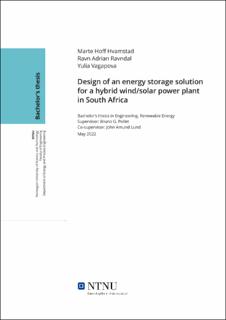| dc.contributor.advisor | Pollet, Bruno G. | |
| dc.contributor.advisor | Lund, John Amund | |
| dc.contributor.author | Hvamstad, Marte Hoff | |
| dc.contributor.author | Ravndal, Ravn Adrian | |
| dc.contributor.author | Vagapova, Yulia | |
| dc.date.accessioned | 2022-07-07T17:21:39Z | |
| dc.date.available | 2022-07-07T17:21:39Z | |
| dc.date.issued | 2022 | |
| dc.identifier | no.ntnu:inspera:110285048:113090669 | |
| dc.identifier.uri | https://hdl.handle.net/11250/3003672 | |
| dc.description.abstract | 74% av energisektoren i Sør-Afrika består av kull. Sektoren klarer ikke å møte energibehovet til landet. Dette fører til at landet opplever daglige planlagte strømbrudd. Kull er en ikke-fornybar og forurensende energikilde. Forandring er nødvendig for at landets energisituasjon skal bli forbedret. For å gjøre landet mindre avhengig av kull, investeres det i fornybarsektoren. Bedriften Norsk Vind utvikler flere ulike vindprosjekter i Norge, men har også et pågående prosjekt i Tanzania. De ønsker å ekspandere videre i Afrika med et hybrid vind/sol kraftverk i Sør-Afrika. Dette skal bidra til at landet tar i bruk sine rike sol- og vindressurser.
Den planlagte hybrid kraftstasjonen består av tre 70 MW solkraftverk og to 140 MW vindkraftverk. Målet for denne avhandlingen er å undersøke om det ville ha vært økonomisk gunstig å inkludere et batteri energilagringssystem i hybridsystemet ved lagringsarbitrasje. Fem ulike batteriteknologier ble undersøkt i utgangspunktet. Det ble bestemt å analysere batteriteknologiene litium jernfosfat og vanadium redox flow batteri.
Dataserier for energiproduksjon fra et solkraftverk og et vindkraftverk ble gitt av Norsk Vind. Disse dataene ble oppskalert for å passe den gitte størrelsen for kraftverket, og deretter analysert med Python og Excel. Inntekten til kraftverket og energilagringssystemet ble funnet ved å bruke forbrukstariffer og simulering av opp- og utladning av batteriene over ett år. Basert på at systemet har en 30 års levetid ble denne inntekten brukt videre for å kalkulere netto nåverdi, intern avkastning og utjevnet lagringskostnad ved hjelp av MATLAB og Excel. Dette ble gjort for å finne det mest økonomisk lønnsomme systemet.
Det ble funnet at det var flere LFP-systemer med 4 til 5 timer i utladningstid og 10-75 MW effektkapasitet som ville ha vært lønnsomme. Systemet med 50 MW/5 timer ble fastsatt som det mest lønnsomme med størst netto nåverdi og intern avkastning, samt lavest utjevnet langringskostnad. Det ble også oppdaget at ingen av de analyserte VRB-systemene var lønnsomme. Gruppen vil anbefale at Norsk Vind ser nærmere på muligheten for å ta i bruk et LFP-batteri energilagringssystem. | |
| dc.description.abstract | 74 of the energy sector in South Africa consists of coal. The sector is unable to meet the energy demand of the country. As a result, the country experiences planned daily power outages. Coal is an unsustainable and environmentally harmful energy source. Change is needed in order to better the energy situation. Investments are done in renewable projects to make the country less dependent on coal. The company Norsk Vind is developing various wind projects in Norway, but has also an ongoing project in Tanzania. They wish to expand on the African continent with a hybrid wind/solar plant in South Africa, to contribute and help the country to utilise their rich solar and wind resources.
The planned hybrid plant consists of three 70 MW solar plants and two 140 MW wind plants. The goal of the thesis was to investigate the profitability of including a battery energy storage system for storage arbitrage purposes. Initially five different battery technologies were researched, with the lithium iron phosphate battery and the vanadium redox flow battery being chosen for further investigation.
Data series for energy production from solar and wind plants were provided by Norsk Vind. These were scaled to match the given system, then analyzed with the help of Python and Excel. Income from the plant and battery system was found by using time of use tariffs and simulating charging and discharging cycles for the battery technologies over a year. Based on a system lifetime of 30 years, the calculated incomes were used in net present value, internal rate of return and levelized cost of storage calculations with the help of MATLAB and Excel. This was done in order to find the most profitable systems.
It was found that several LFP-systems with 4-5 hr duration discharge and 10-75 MW power capacities would be profitable. The 50 MW/5 hr system resulted in the largest NPV and IRR, in addition to the lowest LCOS. It was also discovered that none of the VRB-systems were profitable in this case. The group would recommend Norsk Vind to further look into a LFP battery energy storage system. | |
| dc.language | eng | |
| dc.publisher | NTNU | |
| dc.title | Design av et energilagringssystem for et hybrid vind/sol kraftanlegg i Sør-Afrika | |
| dc.type | Bachelor thesis | |
